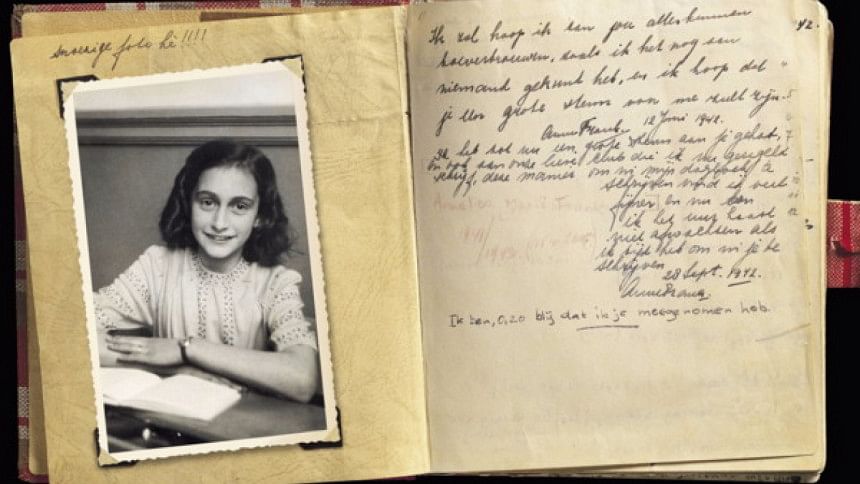Beyond the pages of Anne Frank’s diary

On the first day of this month, 76 years ago, Anne Frank wrote her last diary entry. Three days later, on August 4, the building she was hiding in with her family and four family friends was raided by the Gestapos.
Much of what most people know of Anne Frank comes from this diary. But is a documentation of two years—two extremely intense, painful and eventful years—enough to fully get an insight into the life of a person who is now universally considered a symbol for the victims of oppression and discrimination?
Intending to familiarise the world with the person who existed beyond the pages of her diary, Austrian journalist Melissa Müller embarked on a period of extensive research in the 1990s, locating and interviewing Anne's friends and extended family members. Her book, Anne Frank: The Biography, was published in 1998. The book not only traces Anne's life but also fleshes out all that shaped her and helped her grow, teeming with details of the things she experienced, and expansive backgrounds of and anecdotes about the people Anne knew.
The fact that Anne, over the course of her period in hiding, evolved as a person is evident from her diary entries. She can be found reflecting on her mistakes and flaws, and eventually discovering what she most excelled in: writing. Anne busied herself with honing this craft, writing short stories, essays and fables, and editing her diary which she aimed to publish after the war. Her surviving writings (other than the diary) were compiled in Tales from the Secret Annex (1949). The pieces in this collection show a maturing writer in pursuit of a voice of her own.
This ambitious young person, keen on learning and honing her potential, was largely influenced by her parents, Edith and Otto Frank. One of Müller's main objectives was to discover more about Edith Frank. In Anne Frank: The Biography, Müller's exhaustive research is able to shed light on Edith's family, childhood and adolescence, how she—along with her husband and daughters—had to flee to Amsterdam after the Nazi party came to power in Germany, and how determined they were to keep their family safe while hiding in Amsterdam. Edith's was a tragic life marked by disparities. She was brought up in a well-off family and surrounded by people who loved her, but she ultimately died of starvation in Auschwitz, separated from everyone she loved. Müller's careful portrayal of the woman helps us understand someone who was often unfairly judged by her young daughter. On January 2, 1944, Anne wrote in her diary: "I was furious at Mother (and still am a lot of the time). Because she loved me, she was tender and affectionate, but because of the difficult situations I put her in, and the sad circumstances in which she found herself, she was nervous and irritable, so I can understand why she was often short with me."
Anne was much fonder of her father. The way she viewed the world was deeply influenced by Otto Frank, who survived the Holocaust and lived to be 91. In The Hidden Life of Otto Frank (2002), biographer Carol Ann Lee shows how his life was characterised by dynamic changes—born to well-off assimilated Jewish parents deeply interested in arts and culture, Otto would go on to fight in the World War I. Once Hitler came to power, he would have to flee the country he had fought for. But misfortunes continued to follow him. Germany invaded the Netherlands in 1940 and two years later, Otto went into hiding with his family, only to be betrayed and arrested in August 1944. Mirjam Pressler tells the fascinating story of Otto's family in Treasures from the Attic: The Extraordinary Story of Anne Frank's Family, published in 2011.
After World War II ended, Otto held on to the hope that his children had survived—but just for a while. He was devastated to learn that Anne and her sister Margot had both died in the Bergen-Belsen concentration camp in Germany in February or March 1945. Haunting accounts of their lives in the three camps they were in—Westerbork, Auschwitz, and Bergen-Belsen—can be found in The Last Seven Months of Anne Frank (1988), a book by Willy Lindwer based on interviews conducted with several former inmates of these camps, who had interacted with Anne in the final months of her life.
Even though Anne died a tragic death, her words immortalised her. Her writings survived because they were retrieved, after the occupants of the Secret Annex had been arrested, by Miep Gies and Bep Voskuijl, two of the non-Jewish friends who helped them hide. Anne, grateful to them for risking their own lives to save eight people, often wrote about them in her diary. We get a deeper insight into their struggles and bravery from two books: Anne Frank Remembered (1995), a memoir written by Miep Gies in collaboration with Alison Leslie Gold, and Anne Frank, The Untold Story (2018) by Joop van Wijk (Bep Voskuijl's son) and Jeroen De Bruyn.
Besides offering an insight into Anne Frank's life, these books help one to see the world through the eyes of those who, despite watching everything they knew of being crushed under the force of hatred, held their own, some struggling to survive, others struggling to save people. The world remains divided along an uncountable numbers of lines to this day, which have the potential to wreak havoc and destroy lives. We continue to read about Anne Frank because it shows us the damage these things can result in, and it can inspire us to keep striving for better.
Shounak Reza is passionate about history, reading, and writing. He can be reached at [email protected]

 For all latest news, follow The Daily Star's Google News channel.
For all latest news, follow The Daily Star's Google News channel. 



Comments